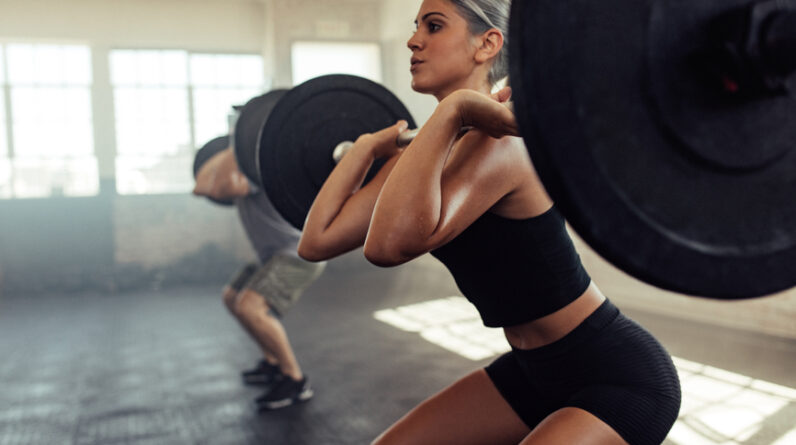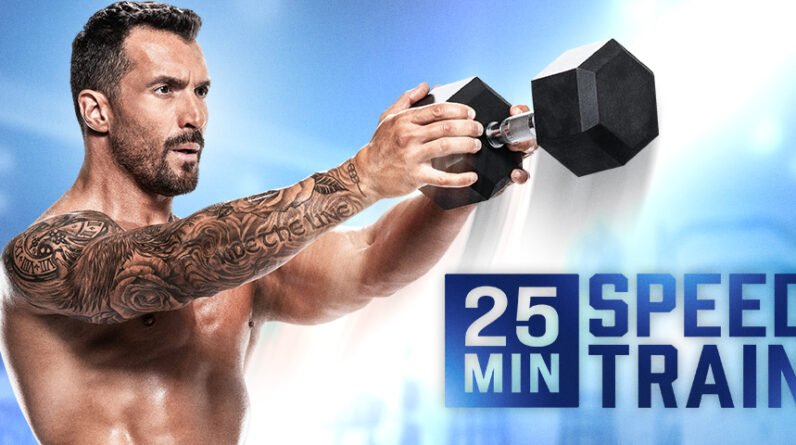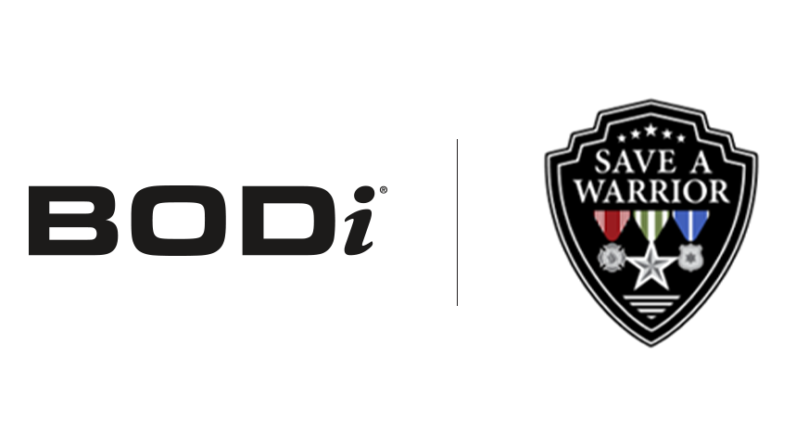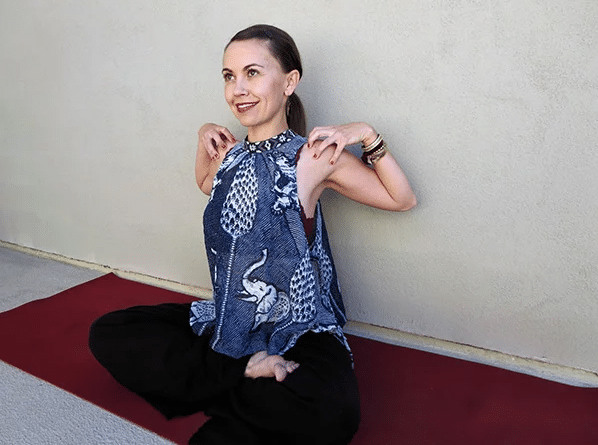
If it’s leg day, it’s time to squat. But with so many variations, where do you start? The two most common are front squats and back squats. Both use a barbell to train the lower body and work similar muscles, making them great for when you’re ready to take your squat game up a notch.
The main difference between the two squat variations is how the weight is distributed over your center of gravity—either in the front or back. In the back squat, the barbell will be supported by your upper back,” says OB/GYN Brittany Robles, MD, a NASM-certified personal trainer and the founder of postpartum health and fitness site Postpartum Trainer. “In the front squat, the weight will be in front of your body supported by your anterior shoulders.”
Experts In This Article
- Brittany Robles, MD, Brittany Robles, MD, is an OBGYN, NASM-certified personal trainer, and founder of postpartum health and fitness site Postpartum Trainer.
- Courtney Sergeant, Courtney Sergeant is an NASM-certified personal trainer and Equinox instructor.
- Danny Saltos, Los Angeles-based certified personal trainer
- Karena Dawn, Karena Dawn is the co-founder of Tone It Up.
The debate around whether front squats or back squats are best is moot, because they both have benefits, and trainers recommend incorporating both into your routine. But adding them to your routine safely requires some squat knowledge. Keep reading to learn which muscles each variation targets and get step-by-step instructions on properly performing front squats and back squats—and tips on making them part of your routine.
How to do front squats, step-by-step
As their name suggests, front squats focus on the front of the body, mainly targeting your quads and core. “The front squat will encourage you to focus on core control as you work to keep your torso upright,” says trainer Karena Dawn, the founder of Tone It Up. You’ll also feel a front squat in your upper-back muscles, glutes, and hamstrings as they’re also engaged during the movement, says Courtney Sergeant, an NASM-certified personal trainer and Equinox instructor. Here’s how to do a front squat properly:
- Start by grasping the barbell lightly with both hands and placing the bar across your shoulders. “Your hands should be placed in an underhand grip just outside your shoulders with your elbows up,” Sergeant says. “Feet should be shoulder-width apart, pointed straight ahead, and with knees in line with the toes. The low back should be in a neutral position.” Danny Saltos, an NASM-certified personal trainer, shares his pro tip for proper form: If the bar stays in place when you remove your hands and straighten your arms, you’re good to go.
- Once you’re in position (hands back on the bar), slowly lower your body, pushing your butt back and down towards the floor, flexing at the hips, knees, and ankles, and making sure your knees don’t go over your toes. To nail the perfect squat, keep descending until your thighs are parallel to the floor.
- Pause when your thighs are parallel to the floor, then squeeze your glutes and quads as you push up through the feet to return to the original standing position.
Need a visual? Watch the video below:
How to do back squats, step-by-step
The OG back squat, Saltos says, is great for increasing overall strength and power, which makes sense given how many muscles it targets. “Having the load on your back will fire up your entire posterior chain—the back of the body,” adds Dawn. You should feel the burn in your glutes, hamstrings, and quads. “The movement also places pressure on the spine, which forces the core to do more work to protect the lower back and keep the body upright,” Sergeant says. Here’s how to do it:
- Back squats are easiest to set up with a racked barbell. Start by grabbing the barbell with a shoulder-width grip, then position yourself beneath the bar, with the bar behind you head.
- While the bar is still racked, Dr. Robles recommends squeezing your shoulder blades together to create a “shelf,” and positioning the bar so it rests on the “shelf.” (The bar won’t be pressed against the back of your neck; it will be slightly below your upper back.)
- Set your stance at shoulder-width apart with toes pointed slightly outwards, at about 15 to 30 degrees. Dr. Robles notes you can go with a wider stance depending on your comfort and mobility.
- Engage your core muscles, slide the barbell off the rack, and stabilize your body before you begin the squat. Dr. Robles instructs you to keep those core muscles tight throughout the entire squatting movement.
- Next up is the squat! Flex at the knees to lower your butt towards the floor, keeping your heels on the floor and making sure your knees don’t go past your toes or collapse inward. “It’s natural for your torso to lean forward some,” says Dr. Robles, but do not bend at the waist. “Keep your spine neutral and your chest up.” Lower your body as much as you can comfortably, ideally until your hips are level with your knees.
- Squeeze your glutes as you push up and return to standing position to complete your back squat.
Need a visual? Watch the video below:
Front squats versus back squats: What’s best for you?
To recap, front squats and back squats are both squat variations that use a barbell to increase the difficulty. Front squats involve placing the barbell in front of the body, thus working the muscles in the body’s front. Back squats involve placing the barbell behind the body, focusing more of the attention on the posterior muscles. Trainers recommend incorporating both into your fitness routine for a well-rounded regime. But, it also depends on your abilities and fitness goals.
For example, if you’re not that flexible, you may want to focus on back squats. “Back squats might be a better option for anyone with limited flexibility in the shoulders, wrists, ankles, or hips,” Dawn says. Back squats don’t require as much mobility as front squats, so they’re also great for beginners who want to build up their strength, says Sergeant.
Front squats, on the other hand, may be a better choice for those with lower-back problems. That’s because the weight is shifted to your quads and there’s less pressure on your spine, says Dr. Robles. However, she notes that front squats require more mobility in the ankles, upper spine, and wrists. Front squats are also the way to go if you have knee pain, as they tend to be easier on those joints. “You might not be able to go as heavy by doing the front squat, but you save yourself some discomfort in your knees and back,” Saltos says.
How to incorporate front squats and back squats into your routine
Before you add weight to your squats, Dawn recommends starting slow and mastering the basic form without a barbell. “You can start with the basic bodyweight squat, then as you get comfortable with the movement, try adding just the barbell with no plates for a back squat,” Dawn says. After you master the back squat, add in the front squat: “It’s definitely a more advanced move, so only progress once you feel your lower body and core strength is there.”
Sergeant agrees: “It’s extremely important to get your form down before adding weight to really build strength and power,” Sergeant says. “A great starting point is completing 12 reps three times before adding weight. Then, add weight gradually.”
The number-one tip when it comes to doing front squats and back squats (or any type of exercise, really) is to listen to your body to figure out what’s best for you. “You want to make sure you have gone through a proper assessment to make sure you are able to do either the front squat or the back squat with proper form and technique,” Saltos says. “Remember, quality over quantity.”
No barbell? No problem. Here’s how to do explosive jump squats the right way:







